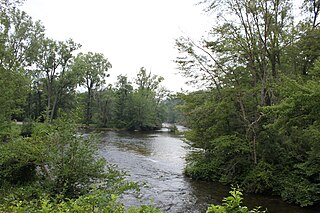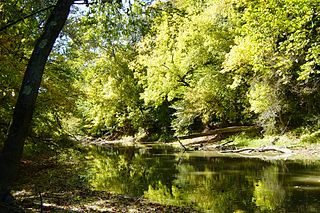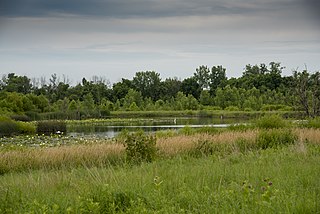
Reynoldsburg is a city in Fairfield, Franklin, and Licking counties in the U.S. state of Ohio. It is a suburban community in the Columbus, Ohio metropolitan area. The population was 41,076 at the 2020 census.
A regional park is an area of land preserved on account of its natural beauty, historic interest, recreational use or other reason, and under the administration of a form of local government.

Hueston Woods State Park is a state park located in Butler and Preble counties of the U.S. state of Ohio, about five miles (8 km) northeast of Oxford in the southwestern part of the state. The park lies in Oxford Township, Butler County, and Israel Township, Preble County. It has nearly 3,000 acres (1,200 ha), including a man-made lake of 625 acres (253 ha). The park's beech-maple climax forest has been designated a National Natural Landmark.

Warren Woods State Park is a 311-acre (1.26 km2) nature preserve and public recreation area in Berrien County, Michigan, near the village of Three Oaks. The state park is leased by private owners to the state of Michigan.
Tinker's Creek, in Cuyahoga, Summit and Portage counties of Ohio, is the largest tributary of the Cuyahoga River, providing about a third of its flow into Lake Erie.

Cleveland Metroparks is an extensive system of nature preserves in Greater Cleveland, Ohio. Eighteen reservations, which largely encircle the city of Cleveland, follow along the shore of Lake Erie and the rivers and creeks that flow through the region. Referred to unofficially as the 'Emerald Necklace', the network of parks spans over 24,000 acres (9,700 ha) and includes over 300 miles (480 km) of walking, bicycle, and horse trails as well as numerous picnic areas, nature education centers, golf courses, and countless fishing spots. In addition, the district includes the zoo in Cleveland. Four of the reservations are adjacent to Cuyahoga Valley National Park.
Summit Metro Parks is a Metroparks system serving the citizens of Summit County, Ohio by managing 14,000 acres (5,700 ha) in 16 developed parks, six conservation areas and more than 150 miles (240 km) of trails, with 22.4 miles (36.0 km) of the Ohio & Erie Canal Towpath Trail.

The Forest Preserve District of Cook County is a governmental commission in Cook County, Illinois, that owns and manages land containing forest, prairie, wetland, streams, and lakes. These land holdings are primarily managed as undeveloped natural areas and for outdoor recreation. The Forest Preserve District encompasses approximately 70,000 acres of land or approximately 11% of the land in Cook County, which contains the city of Chicago and is the most densely populated urban metropolitan area in the Midwest. The Forest Preserves also owns the lands on which the Brookfield Zoo and the Chicago Botanic Garden operate. The Cook County Board of Commissioners also serves ex-officio as the board for the district. The Forest Preserve District headquarters is located in River Forest, Illinois.

The Columbus and Franklin County Metro Parks are a group of 20 metropolitan parks in and around Columbus, Ohio. They are officially organized into the Columbus and Franklin County Metropolitan Park District. The Metro Parks system was organized in 1945 under Ohio Revised Code Section 1545 as a separate political division of the state of Ohio. The Metro Parks are overseen by a Board of Park Commissioners consisting of three citizens appointed to three-year terms without compensation by the Judge of the Probate Court of Franklin County, Ohio. The Board in turn appoints an Executive Director responsible for operations and management of the parks.

The Geauga Park District, among the Ohio Metroparks, manages a system of nature preserves scattered throughout Geauga County, Ohio. The network of 22 open parks, as well as preserves and future parks, encompass more than10,000 acres (40 km2) and includes 60+ miles of walking, bicycle and horse trails, picnic areas, a nature center and abundant fishing holes.
Erie MetroParks was formed as the "Erie County Metropolitan Park District" in 1968 and adopted its current name in 1991. It consists of 14 individual park areas located throughout Erie County in the US state of Ohio covering approximately 3,200 acres (1,300 ha).
Indian Springs Metropark is a park in the Huron-Clinton system of metro parks in the US state of Michigan. The headwaters of the Huron River lie within its boundaries.

Kensington Metropark is a unit of the Huron–Clinton Metroparks system located between Milford and South Lyon, Michigan, USA. The park covers 4,543 acres (18.13 km2). It has wooded hilly terrain and surrounds 1,200-acre (4.9 km2) Kent Lake. The park has an 18-hole regulation golf course, a disc golf course, toboggan hill, a nature center, a farm learning center, picnic areas, beaches, splash pad with water slide and boat rentals. An 8-mile (13 km) paved hike-bike trail, 19 miles (31 km) of horse trails and 7 miles (11 km) of hiking-only trails are available as well as connecting trails to other nearby parks. The only camping is in organized group camping or canoe-in sites. The park receives 2.5 million visitors a year. Kensington Metropark opened in 1947.

Huron Meadows Metropark is a park in the Huron-Clinton system of metro parks. The park covers 1,576 acres (6.38 km2) along the Huron River. It has a regulation golf course, hike-bike trails and self-guided nature trails. In the winter, the park has cross-country skiing and ice-fishing.

Hudson Mills Metropark is a park in the Huron-Clinton system of metro parks in Michigan, USA. It is located on North Territorial Road at the crossing of the Huron River, twelve miles (19 km) northwest of Ann Arbor. The park covers 1,549 acres and has an 18-hole golf course, disc golf courses, picnic areas, swings and slides, softball diamonds, a hike-bike trail, nature trails, river fishing, a canoe camp and a group camp. The park is a popular destination for canoeing and kayaking; parking areas near the Huron River provide access for canoe launching. The park will eventually be linked to Dexter-Huron Metropark and Delhi Metropark via the Border-to-Border Trail. Canoe rentals are available at Delhi Metropark.

Goll Woods State Nature Preserve is a 321-acre (130 ha) nature preserve in western Fulton County, Ohio, near Archbold. It has been designated a National Natural Landmark for its oak–hickory forest.

Slate Run Metro Park is a public park and nature preserve in Madison Township in Pickaway County, Ohio. The park is managed by the Columbus and Franklin County Metro Parks in the Columbus metropolitan area. The park features numerous trails through grasslands, wetlands, forests, and meadows. The park's main water feature is Buzzard's Roost Lake, while nearby Slate Run Creek passes through the park. Amenities include picnic areas and shelters, boardwalks and fishing docks, and several sets of play equipment.

Highbanks Metro Park is a metropolitan park in Central Ohio, owned and operated by Columbus and Franklin County Metro Parks. The park is named for its steep banks along the Olentangy River, the park's most unique feature. Highbanks also features ten trails, picnic space, a nature center, sledding hill, and nature preserve. It also includes numerous ancient burial mounds and earthworks from the indigenous Adena culture.

Pickerington Ponds Metro Park is a metropolitan park in Pickerington and Columbus, Ohio, owned and operated by Columbus and Franklin County Metro Parks. The park has 1,608 acres (651 ha) with several trails and five overlooks for bird and other wildlife watching. It is a State Nature Preserve, primarily focused on providing a habitat for various birds and contains many wetland areas. Pickerington Ponds is designated an Important Bird Area by Audubon Ohio. More than 260 species of birds have been seen here. The park is designated as an Important Bird Area (IBA) by the The Audubon Society.















